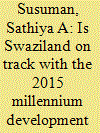|
|
|
Sort Order |
|
|
|
Items / Page
|
|
|
|
|
|
|
| Srl | Item |
| 1 |
ID:
173125


|
|
|
|
|
| Summary/Abstract |
“The Soldier, the State, and the People—Costs and Benefits of Military Regimes”: Evaluating the Essay “Guns and Butter: Child Mortality and the Mediators of Militarization” raises several concerns about the theory and analyses in our article. We address what we see as the three most important: (1) the necessity of both qualitative and quantitative analyses in the study of militarization; (2) correlational versus causal analysis; and (3) the value of Huntington’s analysis of praetorian militarization. We have varying levels of agreement.
|
|
|
|
|
|
|
|
|
|
|
|
|
|
|
|
| 2 |
ID:
163582


|
|
|
|
|
| Summary/Abstract |
Which types of militarization affect child mortality? Which type appears to lower it; which appears to push it higher? This article focuses on social militarization (i.e., troops as a proportion of workforce-aged population) and praetorian militarization (i.e., the military’s control or strong influence over the government), investigating their impact on child mortality using pooled time series analysis covering 142 countries from 1996 through 2008. We find that social and praetorian militarization have opposite effects even after controlling for potentially confounding influences. Access to basic public health infrastructures and education mediates between each type of militarization and child mortality.
|
|
|
|
|
|
|
|
|
|
|
|
|
|
|
|
| 3 |
ID:
140120


|
|
|
|
|
| Summary/Abstract |
Tanzania’s child mortality rate—between 103 and 130 deaths per 1000 live births–is well above the world average. The data from the Tanzania HIV/AIDS and Malaria Indicator Survey 2007/08 were used in order. There were 27,511 children included in the analysis. Regression analysis focused on child mortality based on maternal and fertility behaviours. Children belonging to the group of higher birth order faced 0.17 odds of dying. A birth spacing of 24 months or longer was observed in the successive birth interval for 76% of the respondents. Focusing on the study’s findings, encouraging longer breastfeeding practice is one way to help produce a healthy baby.
|
|
|
|
|
|
|
|
|
|
|
|
|
|
|
|
| 4 |
ID:
157191


|
|
|
|
|
| Summary/Abstract |
According to the Millennium Development Goals (MDGs) agreement, each participating country has to periodically provide a report that will show the progress on their achievement towards the goals. This article’s aim is to evaluate Swaziland’s prospects of achieving eight MDGs by 2015. This article is an analysis of the current situation of Swaziland, and the aim of this analysis is to look beyond the statistical values to see if the achievements (including lifetime achievements) are on track and whether what is yet to be achieved can really be achieved. Secondary information was collected from various sources. Several countries and organizations have committed themselves to the following eight development goals: (1) eradicate extreme poverty; (2) achieve universal primary education; (3) promote gender equality and empower women; (4) reduce child mortality; (5) improve maternal health; (6) combat HIV/AIDS, malaria and other diseases; (7) ensure environmental sustainability; and (8) develop a global partnership for development. National development is dependent on many factors; therefore, different countries across the world have adopted the MDGs as means of alleviating many of the social ills hindering progress and development. Based on different sources, Swaziland is on track with its MDGs, and there is no doubt that Swaziland will continue to work hard to these ends. It has been argued that there has been progress made that has resulted in significant changes to people’s lives, but the question that has to be asked is how long these achievements can realistically last. A reduction of the rate of child mortality, maternal mortality and HIV/AIDS in Swaziland are needed.
|
|
|
|
|
|
|
|
|
|
|
|
|
|
|
|
| 5 |
ID:
100077


|
|
|
|
|
| Publication |
2010.
|
| Summary/Abstract |
Armed conflict typically worsens civilian life chances. The effects of social militarization (maintenance of armed forces) and economic militarization (military expenditures) on civilian life chances are disputed, and the joint effect of armed conflict and militarization on civilian life chances has not previously been examined. This study examines the joint effects of three types of major armed conflicts and two types of militarization on civilian life chances, using a fixed-effects negative binomial cross-national panel analysis (1985-1998) of data from 175 countries with populations larger than two hundred thousand. General economic development, political regime, and country-specific effects are controlled. Armed conflict and militarization interact in affecting civilian life chances. Armed conflict results in higher levels of civilian mortality; militarization interacts with armed conflict, producing the best civilian life chances at either medium-low or medium-high levels of militarization.
|
|
|
|
|
|
|
|
|
|
|
|
|
|
|
|
| 6 |
ID:
110818


|
|
|
|
|
| Publication |
2012.
|
| Summary/Abstract |
Despite accelerated growth there is pervasive hunger, child undernutrition and mortality in India. Our analysis focuses on their determinants. Raising living standards alone will not reduce hunger and undernutrition. Reduction of rural/urban disparities, income inequality, consumer price stabilization, and mothers' literacy all have roles of varying importance in different nutrition indicators. Somewhat surprisingly, public distribution system (PDS) do not have a significant effect on any of them. Generally, child undernutrition and mortality rise with poverty. Our analysis confirms that media exposure triggers public action, and helps avert child undernutrition and mortality. Drastic reduction of economic inequality is in fact key to averting child mortality, conditional upon a drastic reordering of social and economic arrangements.
|
|
|
|
|
|
|
|
|
|
|
|
|
|
|
|
| 7 |
ID:
167830


|
|
|
|
|
| Summary/Abstract |
The article “Guns and Butter: Child Mortality and the Mediators of Militarization” addresses the important subject of the social and political roles of militaries in nations above a minimum population size. Each national population is evaluated in terms of 10 characteristics including survival rates of children, level of armed conflict, economic development, political representation, and others. The authors draw a sharp distinction between social militarization and praetorian militarization. The essay is valuable in providing one dimension of the impacts of militaries on nations. However, qualitative information and analysis would greatly benefit this work. In this regard, the work of Samuel P. Huntington is instructive.
|
|
|
|
|
|
|
|
|
|
|
|
|
|
|
|
|
|
|
|
|